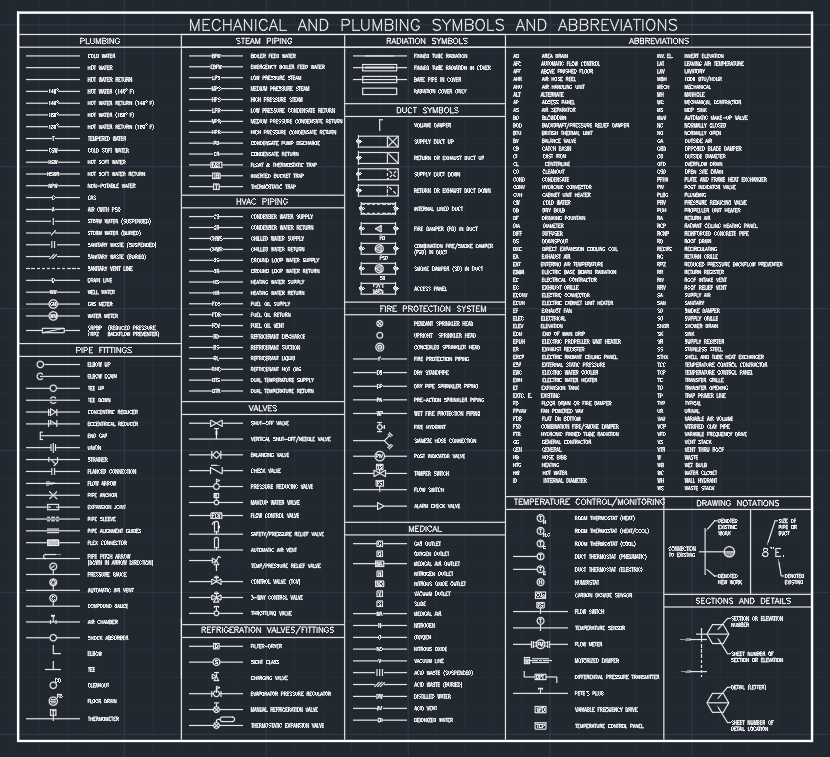Plumbing Abbreviations And Symbols
Plumbing abbreviations and symbols are used to quickly and efficiently communicate information related to plumbing systems. These abbreviations are often used in plumbing diagrams, blueprints, and other technical documents. They can also be used to communicate instructions or information to plumbers and technicians in the field. Knowing the meaning of common plumbing abbreviations and symbols can help you understand the plumbing system and related documents more easily.
Common Plumbing Abbreviations
Common plumbing abbreviations can be confusing for homeowners trying to diagnose their plumbing issues. To help clarify, here is a list of the most common abbreviations used in plumbing and their meanings. CPVC stands for Chlorinated Polyvinyl Chloride, a type of thermoplastic piping used to replace metal pipes in water systems. PEX stands for cross-linked polyethylene, a type of flexible tubing used for water supply lines. PVC stands for Polyvinyl Chloride, a type of plastic piping commonly used in plumbing. ABS stands for Acrylonitrile Butadiene Styrene, a type of plastic piping used in drain and waste systems. DWV stands for Drain, Waste, and Vent, a type of system used to carry waste water away from a building. WWV stands for Water, Waste, and Vent, a type of system used to carry both fresh and waste water to and from a building. GPM stands for Gallons Per Minute, a measure of the rate of water flow in a plumbing system. FPT stands for Female Pipe Threads, a type of fitting commonly used in plumbing. These are just a few of the many abbreviations used in plumbing. Knowing these abbreviations can save time and money when troubleshooting plumbing problems.
Common Plumbing Symbols
Common plumbing symbols are used by plumbers to identify the type of pipes, fixtures, and valves in a plumbing system. This allows them to quickly and accurately diagnose and repair any plumbing issue. From identifying different types of piping to understanding the different types of valves, common plumbing symbols provide a visual guide to understanding the complex mechanics of a plumbing system. Knowing and understanding these symbols can help homeowners quickly identify potential problems and take the necessary steps to resolve them. With a little knowledge of common plumbing symbols, you can ensure your plumbing system is in top shape.

Understanding Plumbing Abbreviations and Symbols
Plumbing is an essential part of any home, and understanding the many abbreviations and symbols used in the trade can help make tackling plumbing tasks easier. This blog provides an overview of the most common plumbing abbreviations and symbols, including what they represent and how to use them. With a better understanding of these terms, you’ll be able to better diagnose, plan, and execute your next plumbing project.

Important Plumbing Abbreviations and Symbols
When it comes to plumbing, there are a lot of abbreviations and symbols that you need to know. From P-traps to S-bends, understanding the various abbreviations and symbols is essential for any plumber. This blog post is designed to help you become more familiar with the most common abbreviations and symbols so you can become a more efficient and knowledgeable plumber. We will cover everything from the basics, such as CTS and DWV, to more complex terminology like FPT and ODF. With a better understanding of the abbreviations and symbols used in the plumbing industry, you can make sure that you are using the right materials and tools for the job.
Tips for Using Plumbing Abbreviations and Symbols
Having a basic understanding of plumbing abbreviations and symbols can be beneficial for any homeowner or professional plumber. It’s important to be familiar with the abbreviations and symbols used to accurately describe parts and processes and to ensure that any plumbing job is done correctly. Here are some tips for using plumbing abbreviations and symbols:
- Make sure to double-check the meaning of any abbreviations and symbols before using them.
- Use abbreviations and symbols that are commonly accepted and understood within the plumbing industry.
- Familiarize yourself with the symbols and abbreviations used for the type of plumbing work you are doing.
- Pay attention to the context in which an abbreviation or symbol is used.
- Remember that some abbreviations and symbols may vary from region to region.
Following these tips can help ensure that you are accurately communicating with other plumbers and that you are using the correct abbreviations and symbols for any given plumbing job.
FAQs About the Plumbing Abbreviations And Symbols
Q1: What does PVC stand for in plumbing abbreviations?
A1: PVC stands for Polyvinyl Chloride, a type of plastic commonly used in plumbing.
Q2: What does DWV stand for in plumbing abbreviations?
A2: DWV stands for Drain, Waste, and Vent, which are components of a plumbing system.
Q3: What does CPVC stand for in plumbing abbreviations?
A3: CPVC stands for Chlorinated Polyvinyl Chloride, a type of plastic that is used in plumbing systems.
Conclusion
Plumbing abbreviations and symbols are an essential part of the plumbing trade. They are used to indicate how different pipes and fixtures should be connected, and they are used to provide a concise description of a plumbing system. Knowing and understanding the various plumbing abbreviations and symbols can be a big help in preventing costly mistakes and ensuring the plumbing system is installed correctly.







